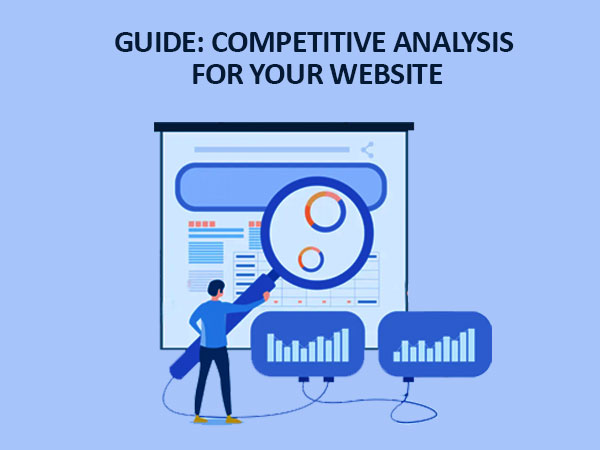In this article, we highlight the importance of competitive analysis and give you a perfect guide to do the competitive analysis for your website.
As a marketer, what should be your primary task? Many terms and ideas might bombard your mind but knowing your target market’s potential is the ultimate goal.
Many companies carry out a one-off competition analysis to develop a digital marketing strategy and determine the market potential. However, most of them leave it at that. That is a common mistake!
Having information about your competitor’s approach helps you adjust your ongoing campaign and get better results. Unknowingly aiming for your audience’s needs and demands will end up in gaining nothing. Neither the consumer nor the provider will benefit from the product or service in question. Entering the market or competing, regardless, knowing your opponent’s game is a must.
This article explains the key points of competitive analysis that you should double-check if your campaign has been running for a while.
IMPORTANCE OF COMPETITIVE ANALYSIS
Competition analysis is the first step before designing and implementing a digital marketing campaign. When we create a digital footprint on the internet to generate more sales, the goal is to develop a presence in front of customers. The fundamental objective is to position ourselves where our potential customers exist. If we know where our potential customers are, then that is where we will place our company and its products or services.
An all-inclusive competition analysis tool allows us to determine our opponent’s strengths and weaknesses and base your target accordingly. Marketers are in search of such a platform that can provide a one-stop solution to get insights. Those brands who came across the competitor analysis tool by SEMrush utilize all the dedicated reports generated with convenient smart data input. The critical figures required to make informed decisions include:
• Web traffic
• Current visitor’s trend
• Knowing the market leaders
• Insights of demographics
• Opportunity to boost ROI
• Successful SEO practices
COMPONENTS OF A COMPETITIVE ANALYSIS
If you seek a practical competitive analysis, the analytics report must have at least the following six studies.
1. WEBSITE AUDIT
The website audit allows us to technically analyze the site of our company and our five main competitors. It includes a specific diagnosis of how they perform in terms of technology, marketing, content, code, analysis, speed, and many other parameters. The audit analysis of our website already opens up a panorama of opportunities for improvement on our website. It allows us to know where we need a revamp for a faster and better-performing website that ranks on Google.
If we run that same web audit to the competitors’ sites, we can discover the areas ahead. A significant section that complements the first analysis is the conversion architecture audit that we review later as the final step.
2. AUDIT OF ORGANIC POSITIONING
The second part of the competition analysis is the audit of organic positioning in Google. This part lets you know how well our competitors rank organically for specific keywords that prospects use to search on Google.
The analysis or audit of organic positioning allows us to know the positions and the traffic generated by our site compared to our competitors’ organic Google listings. Moreover, it will enable the user to determine keywords the opponents use to search for products and services and their rank.
With this information, you can determine which keywords to use for our site’s organic positioning strategy (SEO). The audit allows us to estimate the level of competition we will have in each of these keywords.
3. PAID POSITIONING AUDIT
The third part of the competition analysis is the audit of Google Ads. Most of the sites that follow a professional traffic generation strategy use Google’s advertising models to appear in searches and attract traffic and prospects. It is essential to know which keywords perform the best for advertising campaigns on Google. You can track our competitors’ keywords and estimate how much they are investing in those keywords. This information gives us a clear map of which keywords we have to invest in when we advertise on Google to have the best investment return. It gives us fresh insights into the keywords we can expect to have a higher price per click.
4. SOCIAL LISTENING AND REPUTATION METRICS
The fourth part of competition analysis is reputation analysis, or what is also known as social listening. It is not enough to understand what competitors and brands are doing in their profiles, what kind of content they are posting, and the reactions they generate. We must also know what the people who use social networks think about a product, brand, and category.
We are not talking about the profiles’ followers. The general public is probably posting about the category, product, and brand on other platforms. It has nothing to do with the brand and its competitors. They are merely using social media to express an opinion and a feeling about a service, product, person, political party, a government program, a movie, a song, or an event.
Entering the network, sweeping it, collecting a large amount of data, and identifying everything people are posting brings enormous value. It serves as a thermometer that allows us to gauge what people think about you and how much they talk about that product or service. It helps you monitor the sentiments people express. Social listening is a way to understand each brand’s reputation and products according to the trends.
5. AUDIT OF SOCIAL NETWORKS
Social networks audit helps you identify each of the competitors’ social network strategies to compare it with your brand’s strategy. Competitors often have LinkedIn, Facebook, Twitter, YouTube, and most likely on Instagram and Pinterest. It is essential to know what they are doing on these platforms. Who are they talking to on their profiles? What are they posting? It involves a study of the content they publish and which ones generate more interest and reaction. Which posts generate more interaction? How many followers do they have, and what’s the age of their profile? How often do they publish? A social network audit answers all these questions.
All this information allows us to understand how to design a presence strategy in social networks. You will identify the audiences you want to reach, more relevant content, and potential investment areas. With this audit, we also explore how many people we can impact with a specific volume of advertising investment on Facebook or other social networks. With this, you can define the size of the audience we are going to reach and how you want to impact it.
6. AUDIT OF THE CONVERSION ARCHITECTURE
The conversion architecture is the sales funnel design that your prospect reaches when they finally visit your website. If everything else is up to the mark and you’re getting good organic, social, and paid traffic, the next best thing is to optimize your sales funnel. Your website must have a user-friendly UI and design. This audit will help you identify the loopholes and personalize the user experience. The UX or User Interface of your website defines what you want the prospect to do when visiting your site and how you get it to do what you want.
A conversion architecture audit looks at how the prospect completes an action and what obstacles are in the way that could make their experience more challenging. Finally, it helps you avoid losing any leads and make your website a best-seller.
CONCLUSION
The competitive analysis determines the presence of any brand, products, and services on the internet. It allows you to compare them with your competitors in the digital world. Any company that wants a practical digital marketing strategy should always start with a competition analysis to identify where to invest time, money, and effort. The study allows you to focus your efforts and budget to correctly position yourself in front of a prospect and try to attract them as a customer. A well-focused strategy can overwhelm the competition because you proactively study it. You already know what they do well and what they do and don’t sell. It prepares you to appear much better than your competitors before your target customers.




